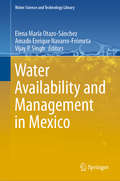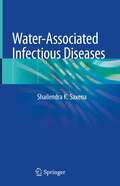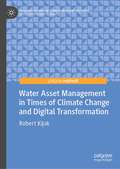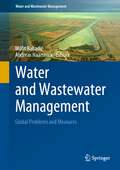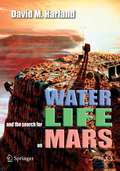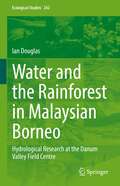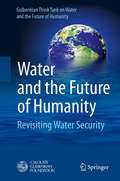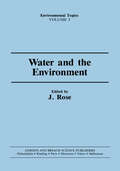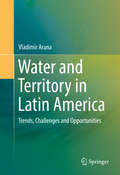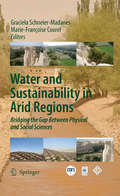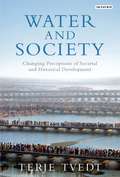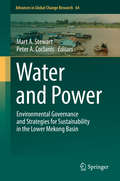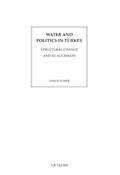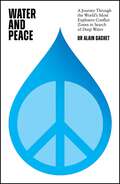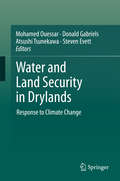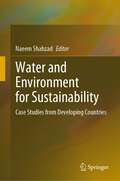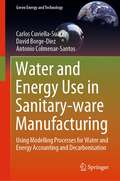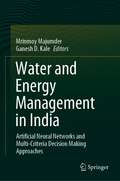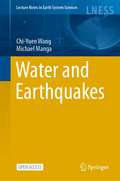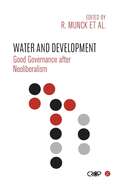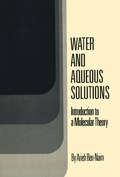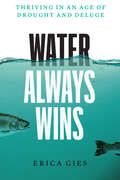- Table View
- List View
Water Availability and Management in Mexico (Water Science and Technology Library #999)
by Vijay P. Singh Amado Enrique Navarro-Frómeta Elena María Otazo-SánchezThis book presents several complex case studies related to water management and planning in the context of pollution, growing demands, and global climate change in Mexico, but which are also relevant for other countries in Latin America. These concerns are of critical importance for policymakers who are coping with multiple conflicting interests. Water availability in Mexico is polarized, with abundant rainfall and large rivers in the south, and desert-like conditions in the north. The central region, which is the most industrialized, is overpopulated. Mexico City pours millions of cubic meters of “blackwater” into the northern valley daily and receives its clean water from the south. To address these unsustainable conditions, the world's 4th biggest water treatment plant went into operation in 2018. The water infrastructure and governance must satisfy the demands of all sectors, including agricultural, urban, and economic activities. At the same time, water resources are affected by drought, and climate change puts constraints on the supply. As such, regulation and monitoring are important when it comes to adherence to agreed plans and priorities. The book is divided into four sections. 1: Water Availability discusses quantitative aspects, such as supply, methods of calculation, and fracking. 2: Water Quality highlights pollution risks and diagnosis of water resources. 3: Water Allocation examines the sectoral demands and vulnerability due to unsustainable irrigation. 4: Water Governance and Management focuses on laws, urban rules, national parks, planning, and integrated water resources management, among other topics. The chapters include illustrative case studies in Mexico, such as basins, cities, reservoirs, and aquifers, water supply demand assessment, planning, and management.
Water Authorities and Supplies for England and Wales (tactile)
by RnibThis is a tactile diagram for GCSE level students. It covers three pages: the first page is a key, with tactile symbols and labels explained, the second page shows a map of the England and Wales with counties labelled, the third shows a bar diagram showing proportions of two different supplies to each county.
Water-Associated Infectious Diseases
by Shailendra K. SaxenaThis book provides a comprehensive overview of the different water-associated infectious diseases and their linked pathogens with plausible strategies for their mitigation. Although, we are in the era of 21st century having most of the advanced technologies at hand, yet water-associated infectious diseases are the major contributors towards the worldwide morbidity and mortality. The book also focuses on the various implementation strategies of sustainable hygienic conditions, discusses the robust, and reliable policies and strategies on a global aspect to provide unprivileged people access to the basic sanitation, hygiene and water. In addition, the book discusses the possible indirect effect of global warming on the spread of infectious diseases through the distribution of associated vectors.
Water Asset Management in Times of Climate Change and Digital Transformation (Palgrave Studies in Climate Resilient Societies)
by Robert KijakIn this book, climate change and digital transformation are explored as key strategic drivers for the contemporary practices of water utility companies. These drivers seem to be separate, but clearly, they are not.The recent weather anomalies in water stressed countries are discussed, which have been breaking records and become an elevated risk to water assets. In parallel, the book examines a contextual proposition that the concept of the fourth industrial revolution applied to the water sector, Water 4.0, assists with the water supply decentralisation and sustainability, in particular climate resilience. It further suggests that the implementation of an Asset Management System with reference to the ISO 55001 standard is a useful tool in this process.
Water and Wastewater Management: Global Problems and Measures (Water and Wastewater Management)
by Müfit Bahadir Andreas HaarstrickThis volume addresses the situation of water and wastewater management from a global angle, underpinned by selected case studies. Without doubt, water and wastewater management are among the greatest challenges of our century, and there is also no doubt that the challenges posed by climate change will become even greater. However, most efforts, especially in developing countries but also in the so-called developed countries, have been less than optimal or not optimal at all. In particular, there are still too many people who have to live without clean water and decent sanitation. Today, 2.2 billion people lack access to safely managed drinking water and wastewater, and 4.2 billion people lack safely managed sanitation services. The question, why this is so and why in many cases in developing countries, is discussed in this book among other urgent water and wastewater management issues.The publication of this book is the start of a book series that in more detail critically reviews, discusses, and analyzes the water and wastewater situation and management in different regions and countries worldwide.
Water and the Search for Life on Mars (Springer Praxis Books)
by David M. HarlandProvides a comprehensive account of the recent ‘Spirit’ and ‘Opportunity’ Mars Exploration Rover missions. Relates how NASA/ESA have sought evidence of life on Mars, with the prevailing mood sometimes being optimistic and sometimes pessimistic. Details an account of the rationale for the tests for life carried out by the Viking missions in 1976, with an account of the debate over their results. A concise primer for readers wishing to ‘bone up’ when NASA next sends a lander explicitly to seek life on Mars. Discusses the nature of life on Mars in terms of the most primitive forms of life on Earth, and reviews the implications of there being life on both planets.
Water and the Rainforest in Malaysian Borneo: Hydrological Research at the Danum Valley Field Studies Center (Ecological Studies #242)
by Ian DouglasThis volume synthesizes and analyzes thirty years of hydrological research in the Danum Valley Conservation Area, a lowland dipterocarp rainforest in Sabah, Malaysia. Ian Douglas explores the role of water in the rainforest ecosystem, setting out the ecological, climatological and geological context of present-day hydrological processes, soil erosion and stream sedimentation. He emphasizes the role of extreme events and natural disturbances in sediment supplies and the evolution of drainage pathways and explains the pathways of rainfall and stream sediment. Douglas then explores the impacts caused by logging, the extreme pulses of sedimentation and the effects of log removal and logging road construction, examining the effects of major storms in the 20 years after tree harvesting. Methods of minimizing logging damage to soils and streams are discussed and the effects on flora and fauns are considered.
Water and the Future of Humanity: Revisiting Water Security
by Gulbenkian Think Tank on Water and the Future of HumanityThis unique, engaging, and highly authoritative volume enlightens readers on changes needed in the way society accesses, provides, and uses water. It further shines a light on changes needed in the way we use food, energy, and other goods and services in relation to water, and offers projections and recommendations, up to 2050, that apply to water access challenges facing the poor and the common misuse of water in industry, agriculture, and municipalities. Written by an unparalleled slate of experts convened by the Calouste Gulbenkian Foundation, the book takes on one of the most critical issues on the planet today. In a frank yet optimistic assessment of major developmental challenges, but also opportunities, facing future generations, the author elucidates linkages between water and a range of other drivers from various disciplinary and stakeholder perspectives. Ultimately portraying the belief that Humanity can harness its visionary abilities, technologies, and economic resources for increased wellbeing and sound stewardship of resources, the book presents an optimistic statement stressing actions scientists, policy makers, and consumers can and must take to meet the water management challenges of a warming planet anticipating nine billion inhabitants by 2050.Gulbenkian Think Tank on Water and the Future of Humanity: Benedito Braga, Pres. World Water Council & Prof. of Civil Engineering, Univ. of São Paulo, Brazil; Colin Chatres, Director General of the International Water Management Institute, Sri Lanka; William J. Cosgrove, Pres. of Ecoconsult Inc. & Senior Adviser for the UN World Water Development Report, Canada; Luis Veiga da Cunha, Prof. Environmental Science and Engineering, Universidade Nova de Lisboa, Portugal; Peter Gleick, Pres. of the Pacific Institute, USA; Pavel Kabat, Director, International Institute for Applied Systems Analysis, Austria; and Prof. & Chair, Earth Systems Science, Wageningen University, The Netherlands; Mohamed Ait Kadi, President of the General Council of Agricultural Development, Morocco; Daniel P. Loucks, Prof. of Civil Engineering, Cornell Univ. USA; Jan Lundqvist, Senior Scientific Advisor, Stockholm International Water Institute, Sweden; Sunita Narain, Director, Center for Science & Environment, New Delhi, India; Jun Xia, Pres., International Water Resources Association, Chair Prof. & Dean, The Research Institute for Water Security (RIWS), Wuhan University, China.
Water and the Environment
by J. RoseThis compilation of papers provides useful insights on the differing approaches to water quality and the diversity of strategies in water quality management worldwide. Considering the current situation and looking to the future, the aim of this publication is to provide a sensible addition to the literature by concentrating on several important aspects of water and the environment.
Water and the Environment
by J. RoseThis compilation of papers provides useful insights on the differing approaches to water quality and the diversity of strategies in water quality management worldwide. Considering the current situation and looking to the future, the aim of this publication is to provide a sensible addition to the literature by concentrating on several important aspects of water and the environment.
Water and Territory in Latin America: Trends, Challenges and Opportunities
by Vladimir AranaThis book focuses in the current situation of water resources, water supply and sanitation, and population movement in Latin America. It identifies new phenomena and challenges that will put more pressure on water resources in the near future and that will create important socioeconomic constraints in population and their governments. This volume offers an evaluation of water resources availability and consumption, water supply and sanitation shortages, management models and population growth and territory occupation trends in eighteen Latin American countries. Also a set of recommendations, policy proposals and projects is outlined.
Water and Sustainability in Arid Regions: Bridging the Gap Between Physical and Social Sciences
by Graciela Schneier-Madanes Marie-Françoise CourelInternational voices fill the pages of Water and Sustainability in Arid Regions, forming an original scientific exploration of current water research and management issues. In arid regions, agriculture that is ill-adapted to the environment, accelerated urbanization, poverty, and increasing pollution challenge access to and uses of water. Understanding these issues requires incorporating findings from both the physical and social sciences at different temporal and spatial scales. The chapters in this book were written by hydrologists, remote sensing specialists, ecologists, historians, economists, political scientists, architects, archaeologists, and other experts who live in and study arid lands. The authors present updates, overviews, and analyses of water challenges these areas have faced and are striving to address, from salinization in the fabled Taklimakan Desert in China to land degradation in the northern Mediterranean to groundwater over-exploitation in the southwestern United States. The book also examines desertification, remote sensing, qanat systems, architecture, arsenic contamination, and other case studies from Iran, the Maghreb region, Argentina and Chile, and Mexico. From this conceptual mosaic of comparative perspectives and research methods emerges a strong assumption: an interdisciplinary approach that combines physical and social sciences is the first step toward globally and comprehensively addressing water and sustainability."This book is a valuable and welcome contribution to the discussion of water and sustainable development. Through the collection of chapters, the book clearly illustrates the contemporary diversity of approaches to water scarcity and presents pertinent and new research findings that readers generally do not find compiled together. The result is a highly relevant, accessible, and timely resource that is unique in its international and interdisciplinary content. This is a must-read for anyone working on environmental and sustainability issues in arid lands."André Mariotti, University Pierre et Marie Curie, and INSU - CNRS (National Institute for Earth Sciences and Astronomy-National Center for Scientific Research/Centre National de la Recherche Scientifique), France "Anyone who reads this book will find himself or herself contemplating the need to rethink how we approach the issue of water and sustainability in arid lands. Drawing on the expertise of both physical and social scientists, the chapters taken as a whole present global, historic, and current perspectives on water scarcity in a multi-layered way that rarely has been done before." Miguel Solanes, Madrid Water Institute, Spain
Water and Society: Changing Perceptions of Societal and Historical Development (International Library of Human Geography)
by Terje TvedtDespite the central importance that water has held for civilizations both ancient and modern, its social significance has made surprisingly little impact on our contemporary understanding of human history and development. Dominant interpretations of the relationship between society and nature have remained water blind. In Water and Society historian and leading water expert Terje Tvedt argues for a change that acknowledges the significant role played by water in societal development.
Water and Power: Environmental Governance And Strategies For Sustainability In The Lower Mekong Basin (Advances In Global Change Research #64)
by Peter A. Coclanis Mart A. StewartThis book brings together a talented international group of scholars, policy practitioners, and NGO professionals that explores a range of issues relating to environmental, developmental, and governing challenges on the Mekong, one of the world’s greatest rivers and, alas, one of the most endangered. The book is divided into three sections devoted in turn to historical perspectives on the Lower Mekong Basin. Issues relate to livelihood strategies, environmental threats, and adaptation strategies; and various aspects of river governance, with individual authors treating questions of governance at different levels of refraction and in different registers. The result is a fresh and innovative collection of essays, which, taken together, provide much-needed new perspectives on some of the most important and seemingly intractable environmental and development issues in contemporary Asia.
Water and Politics in Turkey: Structural Change and EU Accession (International Library of Human Geography #20160728)
by Vakur SumerThe Water Framework Directive of the European Union is the centrepiece legislation for the management of European waters. It is regarded by many as the most significant piece of European environmental legislation ever introduced and it demands a fundamental change in the way that water resources planning and management is understood. As Turkey approaches EU membership it faces the challenge of implementing the requirements of the WFD by the date of its accession to the union, something that will require major structural change and financial investment. Water and Politics in Turkey provides a comprehensive, detailed and authoritative examination of all aspects water management and water resources in Turkey, from evaluation of existing institutions and practices to assessing the difficulties inherent in the enormous changes that must be implemented as Turkey prepares for EU membership. It will be essential reading for water professionals, policy makers, environmentalists, and all those with an interest in Turkey the workings of the European Union.
Water and Peace: A journey through the world's most explosive conflict zones in search of deep water
by Dr Alain GachetIn countries where scarce surface water causes disease and conflict, an abundance of water can bring peace.With the growing impact of climate change, an estimated one third of the world's population lacks fresh water. By 2050 it could well be over half, some five billion people.Alain Gachet, known as the "Wizard of H2O", explores and unravels the interrelated humanitarian, environmental, scientific and geo-political concerns generated by water scarcity. An archaeological explorer and mining engineer, Gachet has developed a technology (using Nasa satellite imagery) to identify massive aquifers beneath the earth's surface using a mathematical algorithm that could completely change our future.As well as exploring our current environmental crisis (and offering some solutions), Gachet gives an account of his extraordinary adventures as a mining engineer both before and since he became an expert in deep groundwater - in Congo; in Libya, where he has an audience with Colonel Gaddafi; in Darfur, where he works alongside refugee agencies to provide water to vast camps, often at risk to his life; in Iraq and in Kurdistan, where he encounters both the Peshmerga and the Yazidi people; and in the Turkana region of Kenya, where his discoveries of vast underground reservoirs have been transformative to the lives of the people in an area plagued by drought and disputes over livestock for generations.Gachet discusses the critical issues of climate change and desertification, melting glaciers and rising sea levels, but this is also a book about the people he meets in some of the world's most challenging zones of conflict and deprivation. Ultimately this is a book of hope as we explore some of the solutions for the future."If the quest to find high-quality water for millions has a superstar, that person is Alain Gachet. Living a truly adventurous life in a scientific field where underground water is hidden and elusive, he has advanced the science and, at the same time, uniquely served society. This is an exciting story of risk, daring, hydrophilanthropy, and reflection on one of the most important challenges facing humankind." DAVID K. KREAMER, President, International Association of Hydrogeologists
Water and Land Security in Drylands: Response to Climate Change
by Mohamed Ouessar Donald Gabriels Atsushi Tsunekawa Steven EvettThis book presents recent lessons learned in the context of research and development for various dryland ecosystems, focusing on water resources management, land and vegetation cover degradation and remediation, and socioeconomic aspects, as well as integrated approaches to ensuring water and land security in view of the current and predicted climate change. As water and land are the essential bases of food production, the management of these natural resources is becoming a cornerstone for the development of dryland populations. The book gathers the peer-reviewed, revised versions of the most outstanding papers on these topics presented at the ILDAC2015 Conference in Djerba, Tunisia.
Water and Environment for Sustainability: Case Studies from Developing Countries
by Naeem ShahzadThe International Conference on Water, Energy, and Environment for Sustainability (IC-WEES) 2022 is a flagship conference of National University of Sciences and Technology (NUST), Pakistan. With the growing global concerns about environmental degradation, depletion of freshwater resources, and climate change-induced disasters, this year the IC-WEES is focused on climate change, water, environment, and disaster risk reduction (DRR) and their interrelationship with each other. Given the continuous evolution of contemporary scientific research work, it is progressively encouraging that there must be strong collaboration between experts, researchers, and research sharing platforms. Believing in this, the IC-WEES 2022 aims to bring expert individuals and diverse research groups to exchange and share R&D updates and discuss sustainable solutions to challenges in climate change, DRR, environment and water resources management, and respective nexuses between these fields. The conference proceedings consists of multi-disciplinary topics on the themes. As with every passing day, the climate change impacts are becoming visible, there is a dire need to understand the complex inter-relationships of climate changes, environment, water, and energy nexuses in order to lead to more sustainable solutions for our future generations. Our region is presently suffering from unprecedented heat waves, and prospective readers will be quite curious to know about the latest researches being carried out in this region with regard to environment, climate change, and water in order to reduce the disaster risks the continent is likely to face in near future.
Water and Energy Use in Sanitary-ware Manufacturing: Using Modelling Processes for Water and Energy Accounting and Decarbonisation (Green Energy and Technology)
by Carlos Cuviella-Suárez David Borge-Diez Antonio Colmenar-SantosThis book analyses and quantifies how and where energy and water are consumed by the ceramic sanitary-ware industry and provides solutions as to how to reduce this. The whole production process is mapped, including modelling methods.The book begins by providing an introduction to ceramic sanitary-ware production and types of factories casting technology. It then moves on to discuss the process and energy modelling for the production line, analysis of energy and water consumptions and proposals for improvements. The last chapter presents the practical implementation of the selected modelling configuration. This book is of particular interest to water and energy management professionals within the ceramic industry, but the methods are of interest to those in other production industries as well.
Water and Energy Management in India: Artificial Neural Networks and Multi-Criteria Decision Making Approaches
by Mrinmoy Majumder Ganesh D. KaleThis book provides an innovative, realistic and reliable solution to the common problem of Indian water and energy sector due to the onset of the Impact of Climate Change and Large-Scale Urbanization. Twelve Case Studies and One Review Paper that were included in this book depict the way soft computation techniques, simulation and decision-making framework can optimize the best solution from multiple solutions to the problems of water and energy management which corresponds to a novel symbiotic and synchronous nexus between water and the energy sector. All the studies included in this book are collected from all parts of India. The selected studies utilized the latest technologies like Multi-Criteria Decision Frame Work, Neural Networks and Nature-Based Optimization techniques to achieve diverse objectives from the prediction of climatic parameters to yield from ungauged watershed to performance optimization of Water Treatment Plant, Hydropower as well as futuristic alternative energy systems like Wave to Power Plants.
Water and Earthquakes (Lecture Notes in Earth System Sciences)
by Chi-Yuen Wang Michael MangaThis open access book explores the interactions between water and earthquakes, including recent concerns about induced seismicity. It further highlights that a better understanding of the response of the water system to disturbances such as earthquakes is needed to safeguard water resources, to shield underground waste repositories, and to mitigate groundwater contamination. Although the effects of earthquakes on streams and groundwater have been reported for thousands of years, this field has only blossomed into an active area of research in the last twenty years after quantitative and continuous documentation of field data became available. This volume gathers the important advances that have been made in the field over the past decade, which to date have been scattered in the form of research articles in various scientific journals.
Water and Development: Good Governance after Neoliberalism (International Studies in Poverty Research)
by Ronaldo Munck, Narathius Asingwire, Honor Fagan and Consolata KabonesaWater has always been a crucial catalyst for human development. In Africa, competition among different sectors for this scarce resource remains a critical challenge to water managers and decision-makers.Water and Development examines a range of issues, from governance to solar distillation, from gender to water pumps, using a range of research methods, from participant observation to GIS and SPSS data analysis. Throughout, however, there is the unifying thread of developing a participatory and sustainable approach to water which recognises it as an essential public necessity.The result is essential reading both for students of development and the environment and for NGOs and policy-makers seeking a robust and transformational approach to water and development.
Water and Aqueous Solutions: Introduction to a Molecular Theory
by Arieh Ben-NaimThe molecular theory of water and aqueous solutions has only recently emerged as a new entity of research, although its roots may be found in age-old works. The purpose of this book is to present the molecular theory of aqueous fluids based on the framework of the general theory of liquids. The style of the book is introductory in character, but the reader is presumed to be familiar with the basic properties of water [for instance, the topics reviewed by Eisenberg and Kauzmann (1969)] and the elements of classical thermodynamics and statistical mechanics [e.g., Denbigh (1966), Hill (1960)] and to have some elementary knowledge of probability [e.g., Feller (1960), Papoulis (1965)]. No other familiarity with the molecular theory of liquids is presumed. For the convenience of the reader, we present in Chapter 1 the rudi ments of statistical mechanics that are required as prerequisites to an under standing of subsequent chapters. This chapter contains a brief and concise survey of topics which may be adopted by the reader as the fundamental "rules of the game," and from here on, the development is very slow and detailed.
Water Always Wins: Thriving in an Age of Drought and Deluge
by Erica GiesA hopeful journey around the world and across time, illuminating better ways to live with water. Nearly every human endeavor on the planet was conceived and constructed with a relatively stable climate in mind. But as new climate disasters remind us every day, our world is not stable—and it is changing in ways that expose the deep dysfunction of our relationship with water. Increasingly severe and frequent floods and droughts inevitably spur calls for higher levees, bigger drains, and longer aqueducts. But as we grapple with extreme weather, a hard truth is emerging: our development, including concrete infrastructure designed to control water, is actually exacerbating our problems. Because sooner or later, water always wins. In this quietly radical book, science journalist Erica Gies introduces us to innovators in what she calls the Slow Water movement who start by asking a revolutionary question: What does water want? Using close observation, historical research, and cutting-edge science, these experts in hydrology, restoration ecology, engineering, and urban planning are already transforming our relationship with water. Modern civilizations tend to speed water away, erasing its slow phases on the land. Gies reminds us that water’s true nature is to flex with the rhythms of the earth: the slow phases absorb floods, store water for droughts, and feed natural systems. Figuring out what water wants—and accommodating its desires within our human landscapes—is now a crucial survival strategy. By putting these new approaches to the test, innovators in the Slow Water movement are reshaping the future.
Water Always Wins: Thriving in an Age of Drought and Deluge
by Erica GiesA hopeful journey around the world and across time, illuminating better ways to live with water. Nearly every human endeavor on the planet was conceived and constructed with a relatively stable climate in mind. But as new climate disasters remind us every day, our world is not stable—and it is changing in ways that expose the deep dysfunction of our relationship with water. Increasingly severe and frequent floods and droughts inevitably spur calls for higher levees, bigger drains, and longer aqueducts. But as we grapple with extreme weather, a hard truth is emerging: our development, including concrete infrastructure designed to control water, is actually exacerbating our problems. Because sooner or later, water always wins. In this quietly radical book, science journalist Erica Gies introduces us to innovators in what she calls the Slow Water movement who start by asking a revolutionary question: What does water want? Using close observation, historical research, and cutting-edge science, these experts in hydrology, restoration ecology, engineering, and urban planning are already transforming our relationship with water. Modern civilizations tend to speed water away, erasing its slow phases on the land. Gies reminds us that water’s true nature is to flex with the rhythms of the earth: the slow phases absorb floods, store water for droughts, and feed natural systems. Figuring out what water wants—and accommodating its desires within our human landscapes—is now a crucial survival strategy. By putting these new approaches to the test, innovators in the Slow Water movement are reshaping the future.
